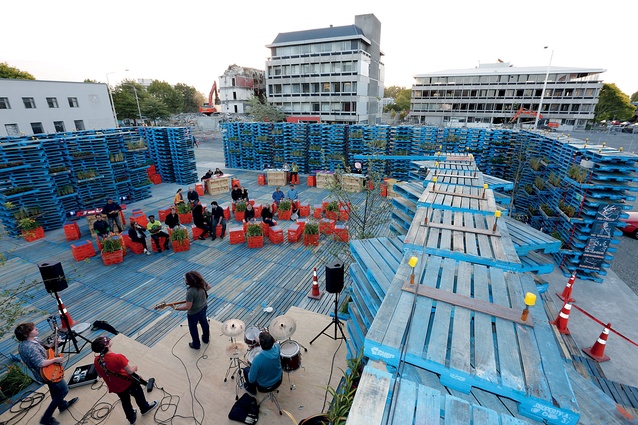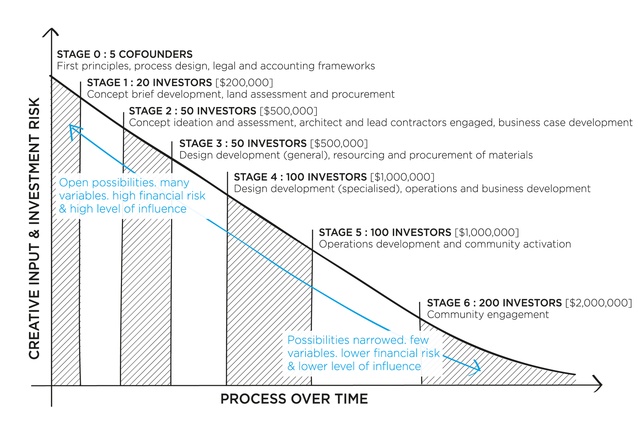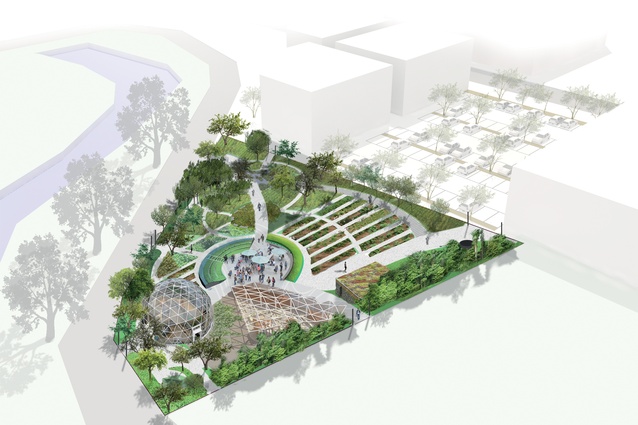An experimental model for commercial property development in Christchurch
What kind of city might be possible if we jumped to the forefront of the digitally enabled contemporary trend for radical inclusivity and creative crowdsourcing?
Dr Ryan Reynolds and Chloe Waretini are pioneering a radical new participatory model for commercial property development in Christchurch.
The creative urban regeneration initiative Gap Filler has been at the heart of the movement to not only bring some life back into Christchurch’s post-earthquake-devastated central city but also to rethink the way cities can be built from grassroots involvement.
Drawing on some of the experimental ways that Gap Filler and others have realised their post-quake community projects, in the following essay, Gap Filler’s co-founder Dr Ryan Reynolds, and Chloe Waretini of the Enspiral Network offer preliminary thoughts about how these learnings could apply to larger-scale and longer-term ventures in Christchurch.
CONTEXT
There is a great deal of building to be done in Christchurch. We are living here with a fairly unprecedented opportunity to create a city in a truly 21st-century way. We can learn from the failures of the 20th century and the dominant expert-led processes that caused so much damage to our cities.
What kind of city might be possible if we jumped to the forefront of the digitally enabled contemporary trend for radical inclusivity and creative crowdsourcing, and began to develop the buildings, spaces and businesses of our city in this same manner? Since the major earthquakes of 2010 and 2011, Christchurch has become world-famous as a city where people are becoming actively involved in shaping their urban environment. In the past five years, it has mostly been the citizens – and small local NGOs – that have been carving out their own ways to be involved. But, slowly, the public and private sectors are recognising the value and opening up more officially sanctioned avenues for citizen participation.
During this same period, the Enspiral Network, headquartered in Wellington, has also received international acclaim for creating an organisational structure with participation and democratic process embedded into the core of its operations. This collective of 300 people uses digital technology and innovative collaborative methods to ensure that they have a diverse group of people working together on common projects to which they all feel invested.
Amid the success of these two movements within New Zealand, and the global trends they are a part of, our question is: how can such participatory models begin to influence permanent public developments and large-scale commercial projects, and bring the same benefits to them?
BENEFITS
So, what benefits have we noticed from our experimental creative and decision-making processes?
In Christchurch, there has been considerable excitement about temporary projects. Much discussion has gone into the value of ‘temporariness’ — but it’s not the temporariness itself that’s valuable. The value is in what is enabled when you open yourself up to new experiments and collaborative processes.
You can rely on creative surprises happening when you bring together a group of people from different backgrounds and disciplines. The scope of what is possible grows and you increase the odds that the initiative is going to effectively serve the people it’s intended to benefit — because they’re right in the room, having a say and taking a stake in its success.
We’ve seen what great projects — and city spaces — can emerge when you bring together diverse minds and enable them to realise a collective ambition that they care about and feel invested in. It increases passion, determination and innovation and, more than anything else, lowers the risk of trying something genuinely new and bold. It’s good for the people involved, and great for cities to have citizens actively, and continually, creating and recreating a sense of place and identity.
BY CONTRAST
Property development is one realm that tends to be limited to the select few; the high financial barriers to entry mean that only those with money can invest their initiative there. We’re sick of reading stories about the blandness of Christchurch’s new buildings, but it’s true: they all seem to be popping out of the same mould with no real innovation.
It’s no surprise — though the risk of developing here is higher than ever. Construction costs have gone way up, there are countless unknowns surrounding vast tracts of the central city, many would-be tenants are locked into long suburban leases and, in parts of the city, the Government is requiring that any development plan be at least half a block.
It seems that fewer and fewer developers are building bigger and higher-cost projects; fewer and fewer architects are taking on higher-stake jobs. With such high financial and reputational risk, you can’t expect there to be any ground-breaking or experimental projects.
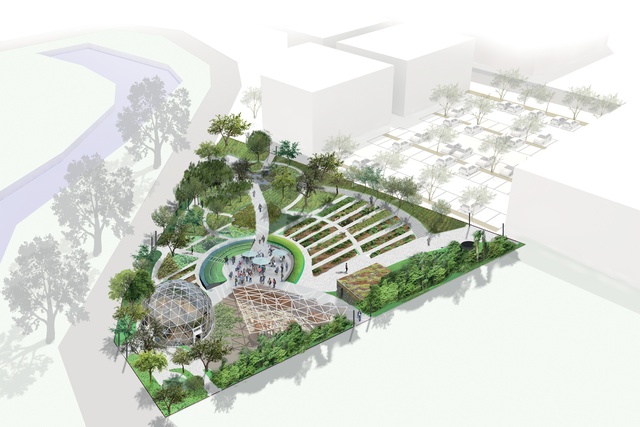
The question then becomes: how can we lower, or decentralise, the financial and reputational risk for such big, permanent projects?
So… we want to lower the financial barriers to entry so that more people can invest their initiative in major developments as citizen-investors. Property ownership – especially beyond private-home ownership – can be seen as an enabler of active citizenship and custodianship of the city. Citizen co-creation could help cities to incorporate distinct local needs, resources and identity into their built fabric. Social and ethical concerns could be better balanced with financial ones. And, importantly, each civic project a citizen invests in grows their ability to contribute meaningfully to their community.
THE PROPOSAL
We are seeking to create a model for collective property development with three key characteristics: distributed financial risk, collaborative process and full life-cycle thinking.
DISTRIBUTED FINANCIAL RISK
We are developing an investment model that significantly lessens the financial risk for any one individual. Lowering the risk could enable a more ambitious, progressive and extraordinary development that experiments with all aspects of the project: the design, built form, business model and operations. Distributing this risk will also open up the opportunity for hundreds of new people to have a direct stake in their city.
There have been major developments worldwide that have made use of equity crowdfunding, where the developer fronts 51 per cent of the development costs and opens up the rest to online investors. This distributes ownership, somewhat, but doesn’t solve our problem: you still have one developer risking a very large amount.
What if, instead, we were to equity-crowdfund an entire development and actually cap the amount that anyone can invest at something like $10,000? It would mean that the project could only go ahead if it attracted a lot of investors, and that nobody could have more than $10,000 at stake. It’s not a guarantee of greatness but it’s a way of maximising the possibility that nobody would veto a wild or untested idea based on financial fears.
COLLABORATIVE PROCESS
All the investors could have an active role in the creative process of the property development. Because of the distributed nature of the investment, no individual would be able to exert disproportionate influence on the outcome through a controlling interest. Instead, structures of influence emerge from individual investors demonstrating expertise, helping peers and adding value to the collective. While the investors wouldn’t necessarily be the lead designers, they would be the most informed and engaged clients any architect could hope to work with.
We’re envisioning a tiered equity crowd-funding and design process, where (say) the first 20 tier-one investors might set the broadest principles for the project and write the high-level concept brief. That brief would be the basis for attracting tier-two investors, who would then join the tier-one group to narrow down possibilities or make a few key decisions: Who do they hire to develop concept designs? What are the top priorities for the project? These decisions attract tier-three investors, who start making more practical decisions about building site, size or materials. And so on.
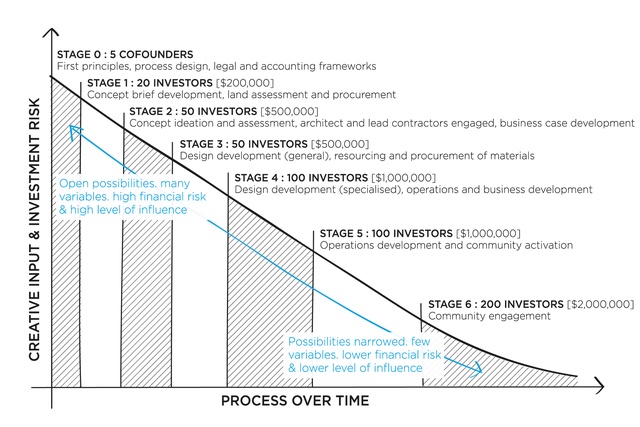
That’s how the participatory investment model could play out - illustrating the different risk and creative input profile of each stage. By stage six, we could have over 500 people having invested a total of $5.2 million into the development.
By the final tier, all of the creative decisions have been made and it becomes a purely financial investment based upon a strong business case – like any other share offer but with the added benefit that hundreds of people are already (financially and creatively) invested in the overall (economic and civic) success of the project. Through this process, it’s conceivable that hundreds of people could meaningfully and creatively be involved in a large city development.
FULL LIFE-CYCLE THINKING
Commercial developments are often marked by segmentation of roles, where each partner is responsible for one small area of expertise and focuses on that. For instance, one company might own the land; a second might build a hotel; a third will lease out the building and operate the hotel. This sets up an extractive rather than generative economy, where each partner tries to clip as much of the ticket as they can at their stage of the process, with very little invested in whether the overall project is a success.
We recognise the benefits of specialisation and, at the same time, believe strongly that full-cycle ownership, investment and operations by a common group of people will mean that the development is more likely to bring true experimentation. A truly novel business and business model — with social as well as financial motivation — is far more likely to emerge in an unconventional building and through an unconventional process. However, the reverse may also be true: there’s no market to develop interesting and radically new buildings unless you can guarantee a novel business that will want to operate from it.
MOVING INTO ACTION
Despite there being a huge amount of recent experimentation in the field of participatory urbanism and distributed investment models, we haven’t yet been able to find an example that combines both of these in commercial property development.
The next steps are research into, and development of, the legal and accounting frameworks required to make this kind of development and investment model both financially viable and compliant with New Zealand regulations.
All of this will feed into a detailed process design for the development, understanding what needs to happen at each stage and how we would coordinate the creative engagement of the investors. In conventional commercial property development, a developer will put in a huge amount of upfront work and research, with the knowledge that there will be a big pay-off at the end if the development goes ahead. In our model, this won’t be the case.
So, one of the challenges we are up against at the moment — one of the flaws of this model — is in how to resource or incentivise this R&D work. When it is completed, we plan to publish our findings publicly so that other people can benefit from what we’ve developed.
IMAGINE…
Imagine a hotel. Typically, this is the type of building that is of no interest or amenity value to the people who live there. Now imagine a local and collective hotel development that directly benefits the citizens - both by giving those hundreds of investors a financial return, and by having local needs and knowledge at the heart of the whole development process. The building, and its business model and operations, would be designed together. How might this group of investors imagine a locally relevant hotel? What might their concierge do? How might they envision their artworks, their room service, their restaurant and events programming?
If the aim is to merge financial and creative investment, and to combine social and economic purposes, imagine developing a Civic Innovation Lab in this way. Imagine the top innovative local businesses, working with the public sector – government, universities and hospitals – and with community organisations and NGOs, to experiment with new civic amenities and initiatives. Imagine what would be possible when the partners involved each had a direct stake in its success, because they were financially and creatively engaged in its creation.
It almost feels as though the post-quake optimism and sense of possibility in Christchurch has evolved into resignation that the new city will be average, coupled with impatience to just get everything done, already. Wouldn’t it be great to rekindle the sense that anything’s possible – and that we don’t need to wait for someone else to do it for us?
To contact Reynolds or Waretini about their participatory development model, email: ryan@gapfiller.org.nz or chloe@enspiral.com.
REFERENCES:
Gap Filler is a creative urban regeneration initiative that facilitates a wide range of temporary projects, events, installations and amenities in Christchurch city.
Enspiral is a virtual and physical network of companies and professionals working together to create a thriving society.

